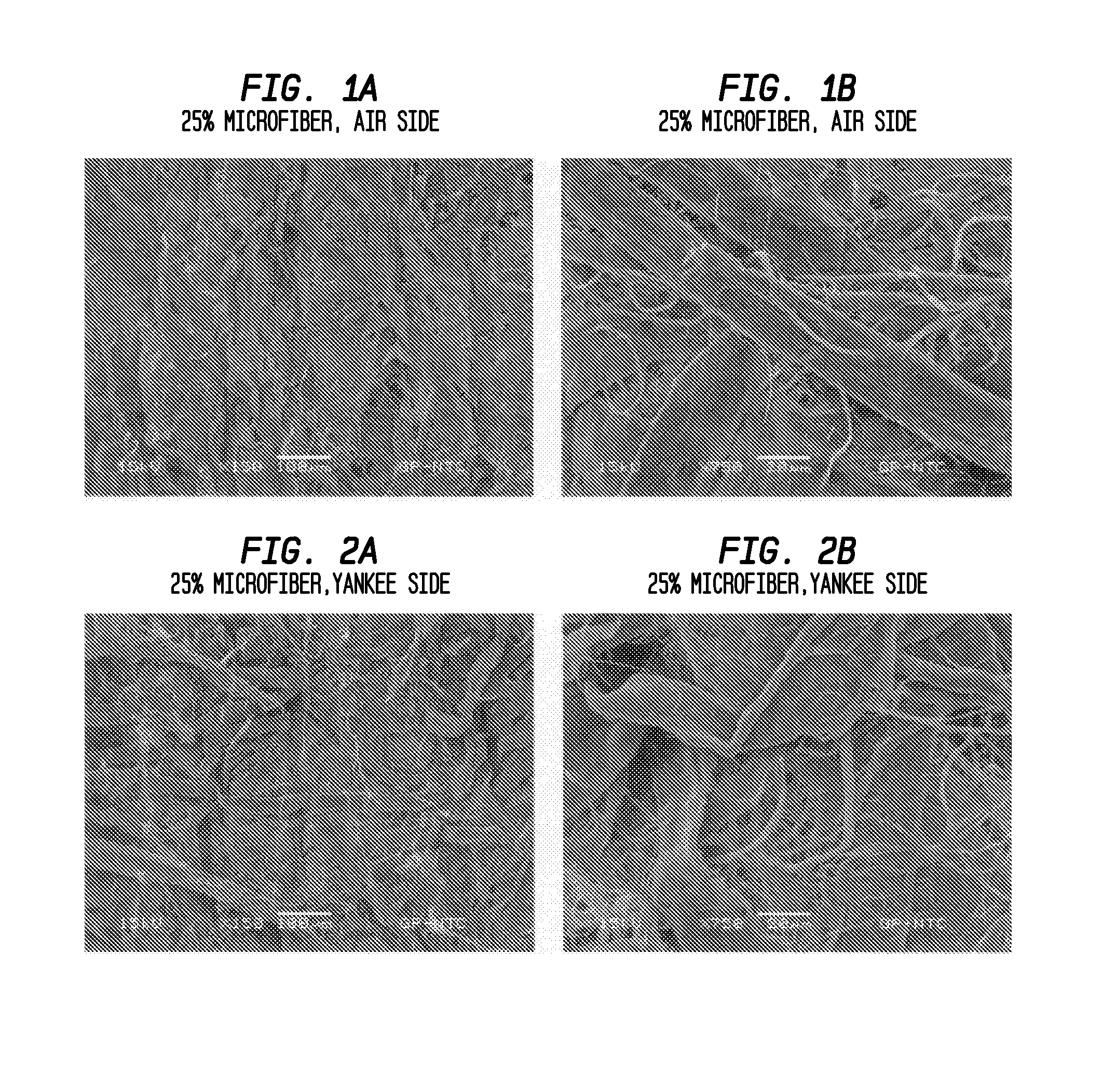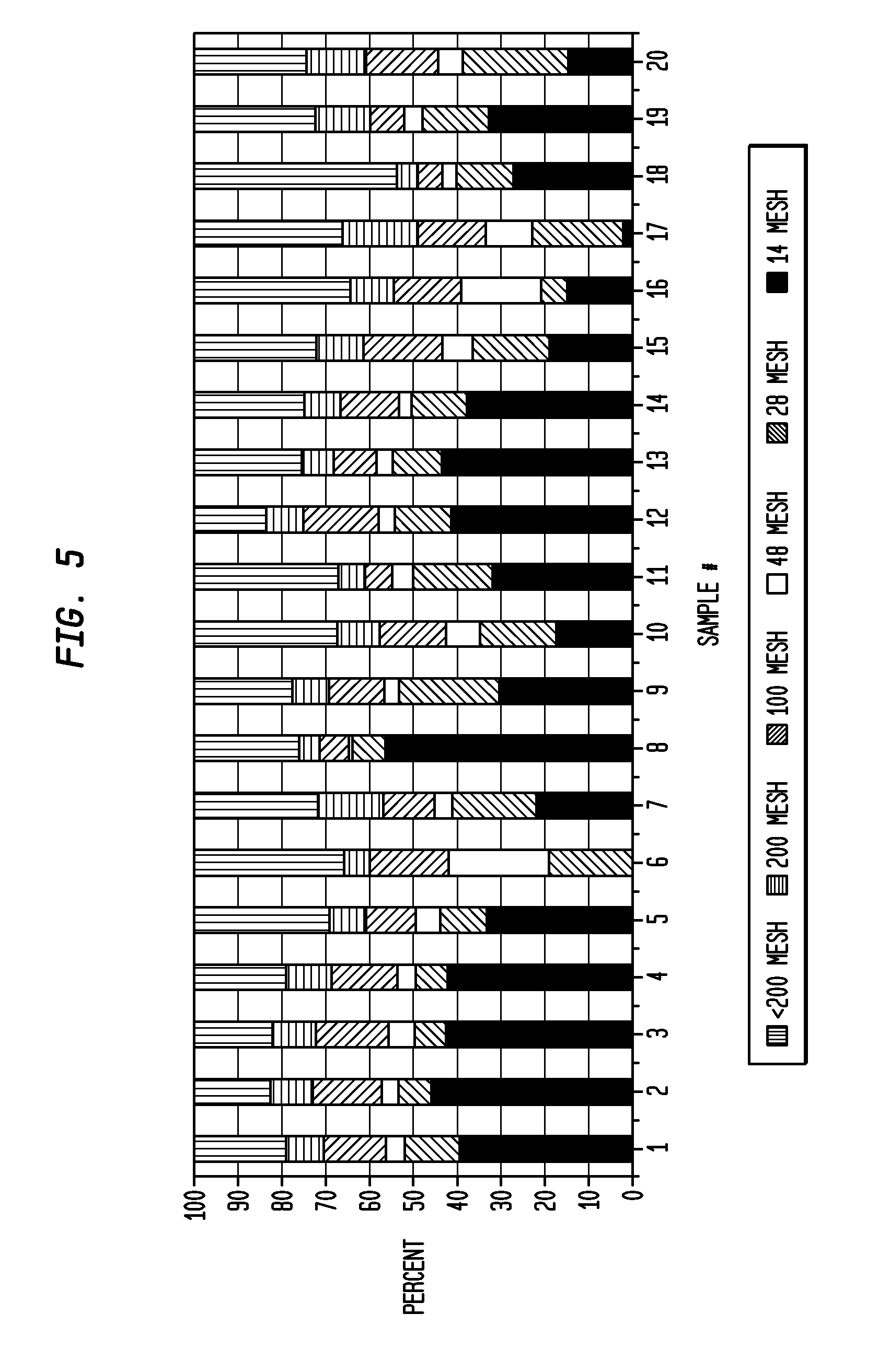High efficiency disposable cellulosic wiper
a cellulosic wiper, high-efficiency technology, applied in the field of high-efficiency wipers, can solve the problems of not being easily re-pulled or recycled, difficult to produce existing products, and not being easily re-pulled and recycled, so as to reduce the amount of cleaning solution, reduce the need for biocides, and increase the effect of effectiveness
- Summary
- Abstract
- Description
- Claims
- Application Information
AI Technical Summary
Benefits of technology
Problems solved by technology
Method used
Image
Examples
examples 1 to 22
[0131]Utilizing pulp-derived papermaking fiber and fibrillated lyocell, including the Sample 17 material noted above, handsheets (16 lb / ream nominal) were prepared from furnish at 3% consistency. The sheets were wet-pressed at 15 psi for 5½ minutes prior to drying. A sheet was produced with and without wet and dry strength resins and debonders as indicated in Table 5, which provides details as to composition and properties.
TABLE 516 lb. Sheet DataRunFormationTensileStretch#Descriptioncmfrefiningcmf sourceIndexg / 3 in.% 1-10 rev, 100% pulp, no chemical009559884.2 2-11000 rev, 100% pulp, no chemical01000101119154.2 3-12500 rev, 100% pulp, no chemical02500102143544.7 4-16000 rev, 100% pulp, no chemical06000102160864.8 5-10 rev, 90% pulp / 10% cnf tank 3, no chemical100refined 6 mm9564634.1 6-11000 rev, 90% pulp / 10% cmf tank 3, no chemical101000refined 6 mm99106984.5 7-11000 rev, 80% pulp / 20% cmf tank 3, no chemical201000refined 6 mm9692304.2 8-12500 rev, 90% pulp / 10% cmf tank 3, no chemic...
examples 23 to 48
[0135]Another series of handsheets was produced with various levels of refining, debonder, cellulose microfiber, and strength resins were prepared following the procedures noted above. Details and results appear in Table 6 and in FIGS. 14 to 16, wherein it is seen that the microfiber increases opacity and bulk particularly.
TABLE 6Handsheets with Debonder and Lyocell MicrofiberBasisOpacityPulpBasisWeightCaliperTAPPISheet%lb / trefining,AdditionWeightRaw5 SheetOpacity#DescriptioncmfVarisoftPFI revsmethodlb / 3000 ft2Wtgmils / 5 shtUnits 1-1100% NBSK - 0 rev; 0 lb / t Varisoft GP -000NA16.040.52214.5850.9C 2-1100% NBSK - 0 rev; 10 lb / t Varisoft0100NA16.920.55115.2053.9GP - C 3-1100% NBSK - 0 rev; 20 lb / t Varisoft0200NA16.200.52715.2154.4GP - C 4-1100% NBSK - 1000 rev; 0 lb / t Varisoft001000NA16.690.54313.4950.7GP - C 5-1100% NBSK - 1000 rev; 10 lb / t Varisoft0101000NA16.720.54413.5450.9GP - C 6-1100% NBSK - 1000 rev; 20 lb / t Varisoft0201000NA16.250.52913.3352.2GP - C 7-1100% NBSK - 1000 rev; 40 ...
examples 49 to 51
[0136]Following generally the same procedures, additional handsheets were made with 100% fibrillated lyocell with and without dry strength resin and wet strength resin. Details and results appear in Table 7 and FIG. 17.
[0137]It is seen from this data that conventional wet and dry strength resins can be used to make cellulosic sheet comparable in strength to conventional cellulosic sheet and that unusually high wet / dry ratios are achieved.
TABLE 7100% Handsheet.xlsBasisTEAWet TensBasisWeightTensileMDFinchDryWetWeight lb / RawMDStretchmm-gm / Cured-MDbreakingBreakingExampleDescription3000 ft2Wt gg / 3 in.MD %mm2g / 3 in.length, mlength, mW / D49No chemical16.340.53234932.80.67818172200.0%504 / 2017.370.56550353.91.4731,943233590138.6%cmc / Amres ®518 / 4016.020.52157384.82.1642,6942887135546.9%cmc / Amres ®
[0138]The present invention also includes production methods, such as a method of making absorbent cellulosic sheet comprising (a) preparing an aqueous furnish with a fiber mixture including from abou...
PUM
| Property | Measurement | Unit |
|---|---|---|
| effective diameter | aaaaa | aaaaa |
| effective diameter | aaaaa | aaaaa |
| diameter | aaaaa | aaaaa |
Abstract
Description
Claims
Application Information
 Login to View More
Login to View More - R&D
- Intellectual Property
- Life Sciences
- Materials
- Tech Scout
- Unparalleled Data Quality
- Higher Quality Content
- 60% Fewer Hallucinations
Browse by: Latest US Patents, China's latest patents, Technical Efficacy Thesaurus, Application Domain, Technology Topic, Popular Technical Reports.
© 2025 PatSnap. All rights reserved.Legal|Privacy policy|Modern Slavery Act Transparency Statement|Sitemap|About US| Contact US: help@patsnap.com



